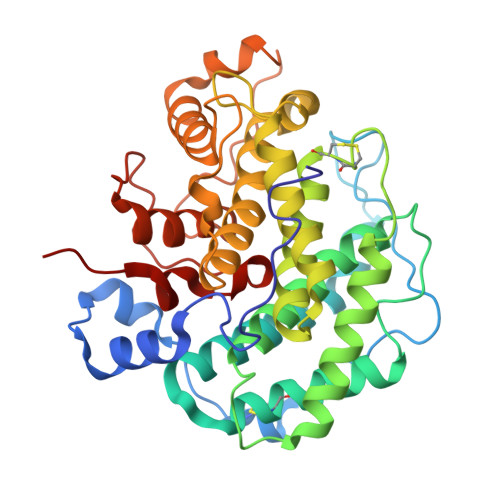Induced-fit motion of a lid loop involved in catalysis in alginate lyase A1-III
Mikami, B., Ban, M., Suzuki, S., Yoon, H.-J., Miyake, O., Yamasaki, M., Ogura, K., Maruyama, Y., Hashimoto, W., Murata, K.(2012) Acta Crystallogr D Biol Crystallogr 68: 1207-1216
- PubMed: 22948922
- DOI: https://doi.org/10.1107/S090744491202495X
- Primary Citation of Related Structures:
4E1Y, 4F10, 4F13 - PubMed Abstract:
The structures of two mutants (H192A and Y246F) of a mannuronate-specific alginate lyase, A1-III, from Sphingomonas species A1 complexed with a tetrasaccharide substrate [4-deoxy-L-erythro-hex-4-ene-pyranosyluronate-(mannuronate)(2)-mannuronic acid] were determined by X-ray crystallography at around 2.2 Å resolution together with the apo form of the H192A mutant. The final models of the complex forms, which comprised two monomers (of 353 amino-acid residues each), 268-287 water molecules and two tetrasaccharide substrates, had R factors of around 0.17. A large conformational change occurred in the position of the lid loop (residues 64-85) in holo H192A and Y246F compared with that in apo H192A. The lid loop migrated about 14 Å from an open form to a closed form to interact with the bound tetrasaccharide and a catalytic residue. The tetrasaccharide was bound in the active cleft at subsites -3 to +1 as a substrate form in which the glycosidic linkage to be cleaved existed between subsites -1 and +1. In particular, the O(η) atom of Tyr68 in the closed lid loop forms a hydrogen bond to the side chain of a presumed catalytic residue, O(η) of Tyr246, which acts both as an acid and a base catalyst in a syn mechanism.
- Department of Applied Life Science, Graduate School of Agriculture, Kyoto University, Uji, Kyoto, Japan. mikami@kais.kyoto-u.ac.jp
Organizational Affiliation:


















